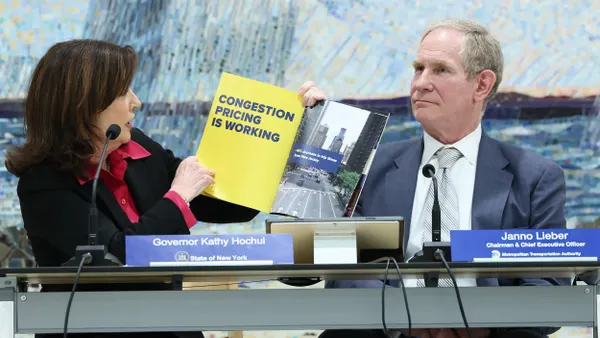Dive Brief:
- Cities and counties allocated the largest share of their American Rescue Plan Act funds to backfilling budget gaps spurred by the COVID-19 pandemic, according to a Brookings Metro analysis of how local governments spent their $130 billion share of the $1.9 trillion stimulus package passed by Congress in March 2021.
- Those decisions were partly driven by Congress requiring recipients to apportion the money by the end of 2024 and spend it by the end of 2026, the analysis found. Spending ARPA funds on “revenue replacement” allowed localities to free up money for long-term priorities, such as economic development, Brookings Metro Visiting Fellow Lavea Brachman said in an interview.
- There has been “tension between being thoughtful and strategic and trying to hit the deadline,” Brachman said. “It’s still going to be a struggle [for cities] to spend this money by then.”
Dive Insight:
Brookings Metro launched the Transforming Cities Lab to help cities pilot transformative projects with ARPA money, Brachman said. For the analysis, the researchers interviewed city officials about projects already funded through ARPA to understand how and why they were selected. The project aimed to uncover how localities could use ARPA funds “in ways that turn out to be more sustainable, more inclusive and more strategic,” she said.
The researchers found that recipients used some of their relief funding to fill budget gaps because “the revenue replacement designation allowed cities and counties to satisfy Treasury reporting requirements and timelines with minimal reporting burdens,” enabling them to dedicate and spend the funds faster, the analysis says.
State, local and tribal governments spent 48% of their money from the State and Local Fiscal Recovery Funds program on government operations and investment. But it’s unclear what percentage of it went to backfilling budget gaps, Brachman said.
Although cities first spent ARPA funds on immediate pandemic aid, many local leaders took the opportunity to pursue high-level priorities such as “affordable housing, homelessness mitigation, inclusive economic and workforce development, and violence prevention and community safety initiatives,” the analysis says. Housing received the second-largest share of SLFRF dollars at 11%.
Cities also made smart, focused investments that could have positive, long-term effects on their residents, Brachman said. For instance, in Minnesota, Ramsey County and St. Paul used ARPA funding to leverage existing workforce development programs, connecting disparate program providers so that county residents can access needed services more easily.
However, Brachman said cities need to be strategic about fiscal spending to ensure benefits from one-time infusions of ARPA funds can continue. For instance, Kansas City funded an affordable housing initiative with bonds in addition to ARPA money, she said.
The full Brookings Metro report on cities’ use of ARPA funds will be released later this year, Brachman said.










